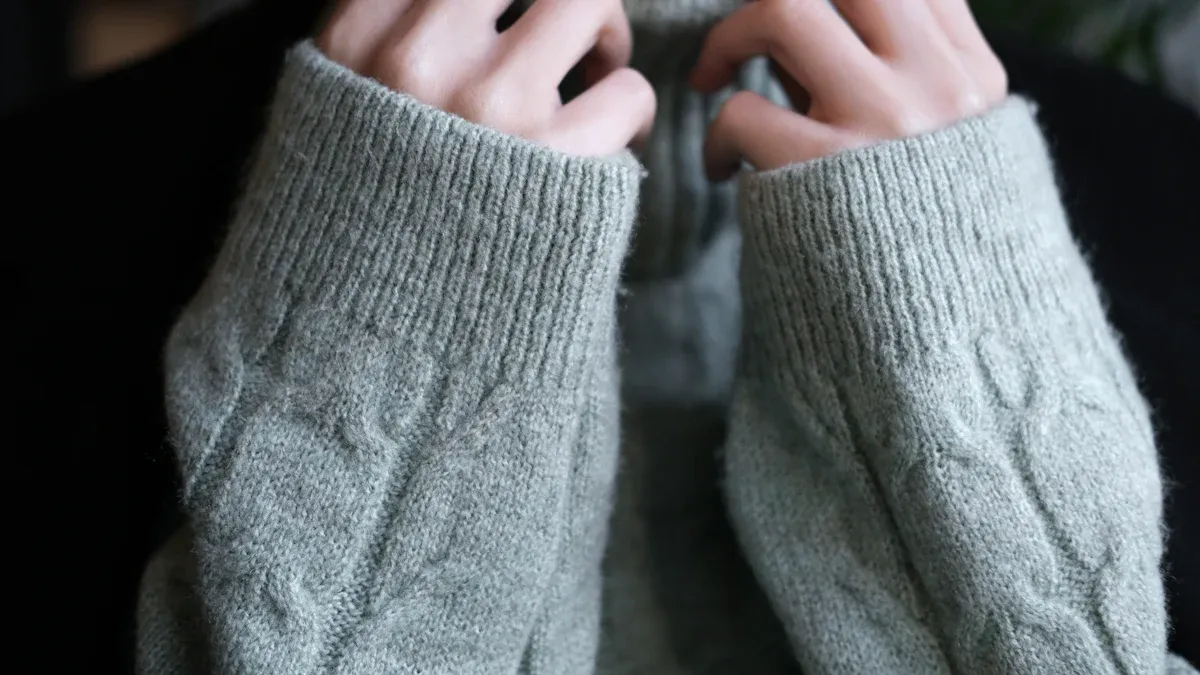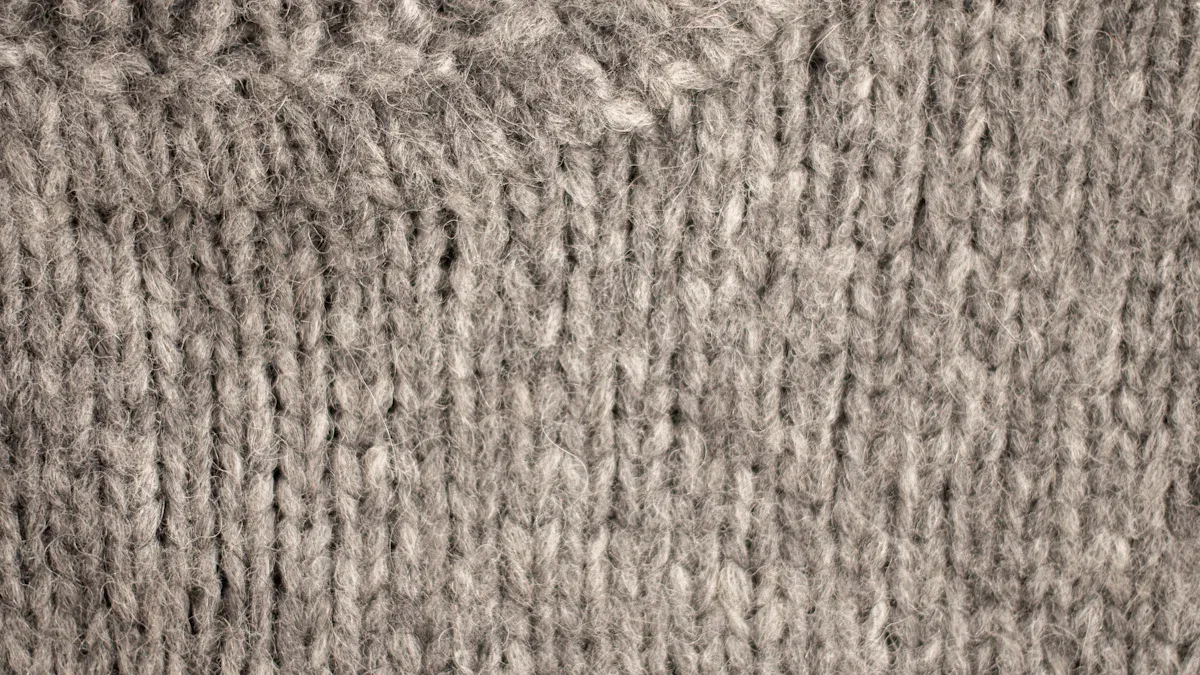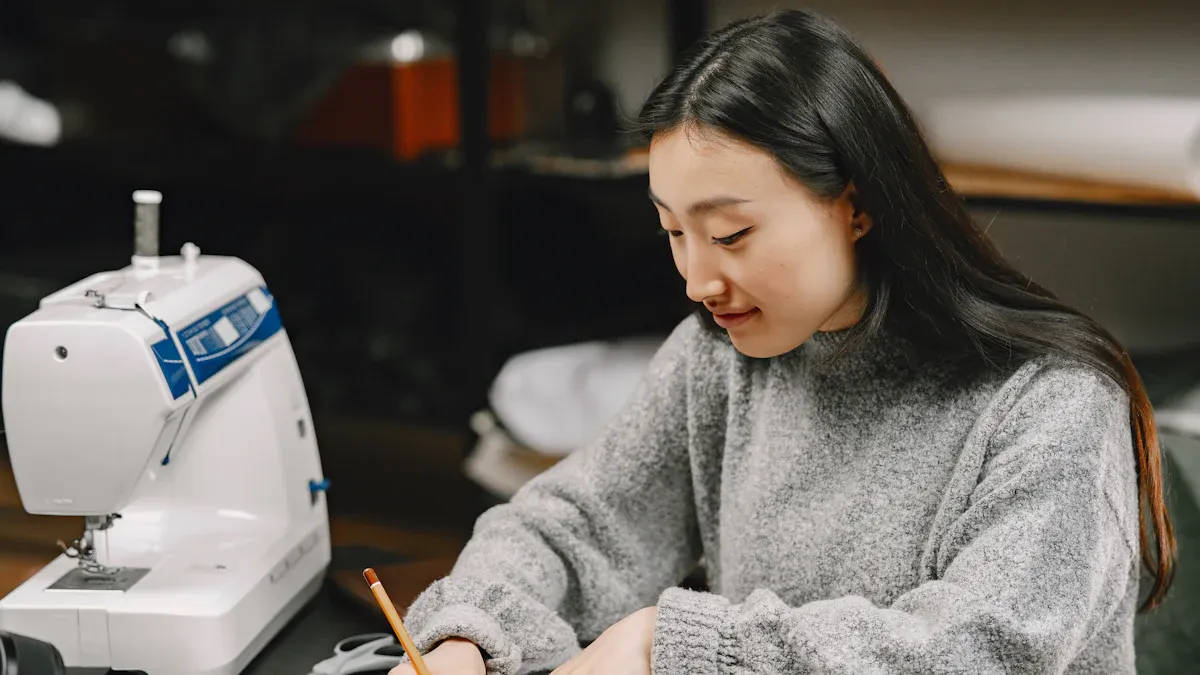
Manufacturing Armani-inspired jumpers begins with selecting the finest silk and merino wool. Designers focus on simple lines and subtle details to create a clean, sophisticated style. Skilled workers employ specialized fine-gauge knitting machines to produce soft, lightweight fabric. Quality control teams meticulously inspect each jumper for softness and shape. Manufacturing Armani-inspired knitwear requires expert craftsmanship and careful attention to detail. Every step involves premium materials and precise work to achieve a luxurious finish.
Key Takeaways
Armani-inspired jumpers use the best silk and merino wool. This makes the knitwear soft, light, and fancy. The design uses simple shapes and plain colors. Layering helps give a classic and stylish look. High-gauge knitting machines make the jumpers feel smooth. Skilled workers help the jumpers keep their shape. Careful steps like washing and blocking are important. Quality checks make sure the jumpers are soft and strong. These steps also help the jumpers last a long time. Picking good and honest suppliers keeps the quality high. It also helps make sure the production is fair and good for the planet.
Style Elements
Jumper Types
Armani-inspired jumper types are known for luxury. Designers pick sweaters and cardigans that fit close to the body. These have simple shapes and clean lines. They use high-quality fabrics for comfort and a classy look. New styles show ribbed knit papillon cardigans in gray and green velvet. These are worn with soft cargo pants. At Milan Fashion Week, cable knits and ribbed sweaters were shown. These styles make luxury fashion feel cozy and stylish. They mix classic looks with modern comfort. That is why they are important in knitwear today.
Minimalist Colors
Minimalist colors are key to the Armani-inspired style. Designers use neutral and single-color palettes like black, gray, navy, and beige. These colors help create balance and symmetry. This matches Giorgio Armani’s design ideas. He gets ideas from buildings and nature. He likes to focus on shape and structure. Using soft colors and nice materials makes each sweater look classic. Sometimes, bright colors or small patterns are used. But the main idea is quiet strength and subtle style. This way, each piece can go with any outfit.
Layering Focus
Armani’s way of layering changes how jumpers look and work.
Designers make jumpers with ribbed collars, cuffs, and hems. They keep the design simple and do not add extra details.
These jumpers can be worn alone or over plain shirts. This makes them useful in many ways.
The simple design lets jumpers be worn as a base or middle layer. This helps create outfits with lots of texture.
Layering fits the minimalist style. It uses texture, not color, to make outfits interesting.
This focus on layering helps people make stylish outfits. It also shows off the quality and comfort of luxury knitwear.
Premium Materials Used in Armani-Inspired Fine-Gauge Silk and Merino Wool Jumpers

Merino Wool
Luxury jumpers often use merino wool. This fiber is very soft and smooth. Most good merino wool has fibers thinner than 24 microns. This makes it gentle on your skin. It keeps you dry by pulling sweat away. Air can move through the fabric, so you stay cool. Merino wool keeps you warm but does not make you too hot. It can stretch and go back to its shape. This helps jumpers last longer and fit well. Many brands pick wool from Australia and New Zealand for extra softness. South African wool is used for more strength. Certifications like RWS and ZQ Merino show the wool is made the right way.
Tip: Try to find jumpers with merino wool you can trace. Certifications mean the wool is good for animals and the planet.
Silk Blends
Designers mix silk with merino wool to make special jumpers. Silk makes the fabric smooth and shiny. This gives the jumper a fancy look. Silk also helps the stitches move better. This makes the jumper hang nicely and move well. Merino wool adds warmth and helps the jumper keep its shape. The mix of silk and merino wool feels soft and fits well. This blend makes jumpers look nice and feel rich.
Fiber | Main Benefit | Effect on Jumper |
|---|---|---|
Silk | Smoothness, sheen | Better drape, elegance |
Merino wool | Warmth, elasticity | Comfort, shape retention |
Yarn Preparation
Yarn preparation is very important for luxury knitwear. Makers pick the best fibers for feel and strength. They test yarns to check if they are strong, soft, and the same color. Dyeing makes sure the colors stay bright and do not fade. Machines are set to match the yarn and keep the right tension. This helps make fabric that is even and high quality. During knitting, speed and tension are watched closely. This keeps the fabric smooth and even. After knitting, treatments help the color and fabric last longer. These steps help jumpers stay soft, keep their shape, and feel fancy.
Manufacturing Armani-Inspired Jumpers

Fine-Gauge Knitting
Making armani-inspired jumpers starts with fine-gauge knitting. Skilled workers use high-gauge machines with many needles. These machines can have 26 to 40 needles in one inch. They help make thin and detailed fabrics. The machines let workers control yarn tension and stitch patterns. This makes the fabric soft and fancy, like luxury brands want.
Machine Gauge (Needles per Inch) | Description | Typical Use in Fine-Gauge Knitting |
|---|---|---|
Low Gauge (6-12 npi) | Thick, strong fabrics with heavy yarns | Not used for fine-gauge luxury jumpers |
Medium Gauge (14-24 npi) | Good mix of thinness and strength | Sometimes used for mid-range knitwear |
High Gauge (26-40 npi and above) | Thin, light, and detailed fabrics | Best for luxury fine-gauge jumpers |
High-gauge machines, like some Japanese models, make special textures and patterns. They use ribbers and second beds to mix knit and purl stitches. This gives the fabric a 3D look. Workers must set the tension just right to keep the fabric soft. The steps often include:
Picking fine, top-quality yarns, usually 1 or 2 ply, for smoothness.
Programming flat-bed knitting machines to make panels with neat edges.
Joining panels by hand or machine for a smooth look.
Washing and brushing to make the jumper softer and smoother.
New technology, like digital flat-bed machines and computer design, helps make jumpers faster. Brands like Max Mara use these tools to make seamless clothes that fit well and waste less. IoT systems help keep yarn tension even, so every jumper is high quality.
High-gauge knitting machines give armani-inspired jumpers their soft feel and fancy look. Careful planning and skilled work are needed to get the right style.
Seam Construction
Seam construction is very important for armani-inspired jumpers. Fine-gauge silk and merino wool need special ways to keep their shape and last long. Seams give support and stop the jumper from stretching out. Set-in sleeves, made in pieces and then sewn together, give a good fit and nice shape.
Mattress stitch is often used to join panels. It makes a flat seam that is strong but not bulky.
Wider but thinner seams, like those in fancy shirts, make the jumper comfy and less bulky inside.
At places like shoulders, workers flatten and re-stitch yarn to remove hard knots. This makes the finish smooth.
Some spots, like V-necks, are knitted as one piece. This removes seams and gives a smooth look.
Seams act like a frame, helping the jumper keep its shape for a long time. This is extra important for silk, which can lose shape if not supported.
Luxury brands use high-quality merino wool because it is soft and keeps its shape. Fully seamless jumpers, where all parts are joined by knitting, feel even softer and look better. Still, good finishing is needed to make them last.
Note: Seamless jumpers may feel softer, but strong seams help them keep their shape and last longer.
Finishing Touches
Finishing touches are what make armani-inspired jumpers special. After putting the jumper together, it goes through many steps to make it soft, smooth, and long-lasting.
Washing and blocking set the size and make stitches even. Blocking helps the jumper stay flat and keep its shape.
Bio wash uses natural enzymes to clean off extra fibers. This makes the surface smoother and stops pilling.
Silicon wash adds a silky feel, making the jumper softer and more flexible.
Light tapes and cotton strips help keep edges, armholes, and seams strong and in shape.
Padding and taping at the shoulders give support but keep the jumper comfy.
Fusible interfacings, like Satin Weave or SofKnit, add softness and drape without making it thick.
Quality checks happen at every step. After washing, blocking, and joining, workers check size, fit, and color. They test for shrinking, pilling, and wear. Only jumpers that pass these tests go to hand finishing. Experts check every detail to make sure it meets luxury standards.
Paying close attention at every step keeps armani-inspired jumpers soft, strong, and beautiful. This shows the care and skill of luxury makers.
Making armani-inspired jumpers needs new machines, skilled workers, and strict checks. Every step, from knitting to finishing, changes how soft, shaped, and stylish the jumper is. Brands that care about these details make knitwear that is comfy, lasts long, and always looks good.
Selecting the Right Suppliers for Luxury Fine-Gauge Knitwear Production
Experience
A supplier’s experience changes how luxury knitwear turns out. Top brands pick partners who have made high-end textiles for many years. Italian and French mills are famous for their long history. They often add hand-finished touches and neat stitching. These suppliers use the best natural fibers and smart knitting methods. Their skills help every jumper meet top standards for quality and care.
Manufacturers with lots of experience make production smoother. They focus on the exact clothes needed, so there are fewer errors and faster work. Good talking and teamwork with these suppliers help brands get the right results. For example, Svevo and Kiton work together because they share goals and have proven success. Brands usually begin with a small group of items, ask for samples, and work with knitwear designers to fix tough problems.
Tip: Pick suppliers who have worked with luxury brands before and can show their samples. This helps make sure the final product is what you want.
The table below shows important things to check when picking suppliers and how they affect the finished product:
Criteria | Description | Impact on Final Product Quality |
|---|---|---|
Material Selection | Use of finest materials such as Italian yarn, cashmere, wool, cotton, and silk blends. | Enhances sophistication, softness, and overall quality of the knitwear. |
Craftsmanship & Knitting Gauge | Expertise in knitting gauges and detailed craftsmanship. | Ensures luxurious finishes and precise, high-quality knitwear construction. |
Sustainability (GOTS Certified) | Prioritizing manufacturers certified by Global Organic Textile Standard (GOTS). | Guarantees ethical and sustainable production, enhancing brand value and consumer appeal. |
Research and Development (R&D) | Focus on innovation, technological advancements, and trend anticipation. | Leads to improved durability, material innovation, and market relevance of the final product. |
Return and Refund Policy | Clear policies reflecting manufacturer confidence. | Provides risk mitigation and assurance of product quality, improving customer trust and satisfaction. |
Transparency
Being open with suppliers helps build trust and keeps a good brand name. Top luxury brands now share their supplier lists and use digital tools to watch every step of making clothes. This change helps brands show they care about doing the right thing and being green. Tools like TrusTrace and Higg BRM let brands check on suppliers and fix problems early.
Some important ways to be open include:
Listing supplier names for others to check.
Using digital tools to follow supply chains and see their effects.
Checking and watching suppliers to make work better and cut pollution.
Working with suppliers on green projects and sharing the work.
Brands that are open gain trust from buyers and lower the chance of bad press. If brands do not share or check on their suppliers, they could get in trouble or hurt their image. When brands like Prada and Chanel buy part of their suppliers, they make sure they get good materials and keep special skills. This also makes it easier to track where things come from.
Transparency Practice | Description | Impact on Brand Reputation |
|---|---|---|
Supplier Stake Acquisition | Brands acquire stakes in suppliers to secure materials and preserve skills. | Improves traceability and consumer trust. |
Public Disclosure of Suppliers | Brands list suppliers on their websites. | Builds trust through openness and accountability. |
Use of Digital Traceability Tools | Brands use digital platforms to monitor supply chains. | Enables better risk management and regulatory compliance. |
Supplier Auditing and Monitoring | Brands audit and monitor suppliers regularly. | Shows commitment to ethical practices and reduces risks. |
Collaboration and Shared Responsibility | Brands and suppliers work together on sustainability. | Fosters a positive brand image and fair climate financing. |
Note: Being open is more than just sharing facts. It means brands and suppliers must keep working together and share the job.
Making Armani-inspired fine-gauge silk and merino wool jumpers takes many careful steps. Designers pick the best fibers and use special knitting machines. Skilled workers finish each jumper to make it soft and strong. These choices help each jumper last a long time and look classic.
Using top materials and expert finishing helps jumpers stay soft and keep their shape for many years.
Brands that care about quality and skill earn trust from their customers.
Good building and fair ways of getting materials help jumpers stay stylish and good for the planet.
By focusing on both design and skill, and working with skilled suppliers, every jumper can reach luxury standards.
FAQ
What makes fine-gauge silk and merino wool jumpers different from regular sweaters?
Fine-gauge silk and merino wool jumpers use thinner yarns and high-gauge machines. These jumpers feel lighter, softer, and smoother than regular sweaters. The fabric drapes well and keeps its shape over time.
How do luxury brands ensure the jumpers stay soft and strong?
Luxury brands use premium yarns and advanced knitting machines. Skilled workers check each jumper for softness and shape. Special washes and careful finishing help the jumpers stay soft and last longer.
Can these jumpers be worn in different seasons?
Yes, these jumpers work well in many seasons. The silk and merino wool blend keeps the wearer warm in cool weather and cool in warmer months. The fabric breathes well and feels comfortable all year.
Why do luxury jumpers cost more than regular knitwear?
Luxury jumpers use the best materials and expert craftsmanship. Brands invest in high-quality yarns, advanced machines, and skilled workers. Each jumper goes through strict quality checks, which adds to the cost.
How should someone care for fine-gauge silk and merino wool jumpers?
Hand washing in cold water or using a gentle machine cycle works best. Lay the jumper flat to dry. Avoid wringing or hanging, as this can stretch the fabric. Always follow the care label for best results.









